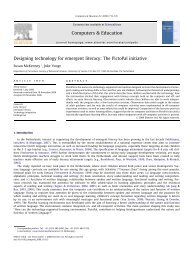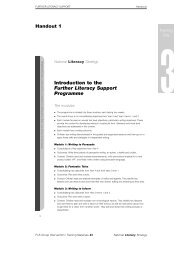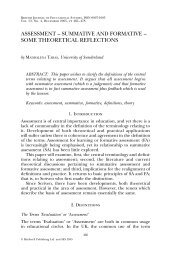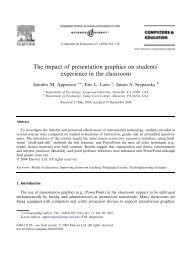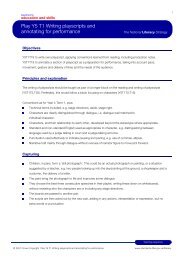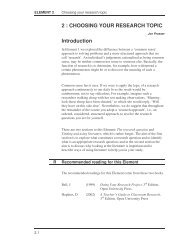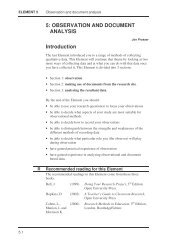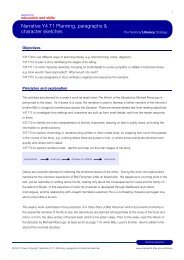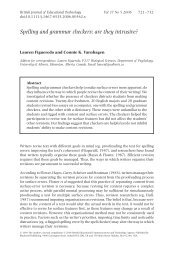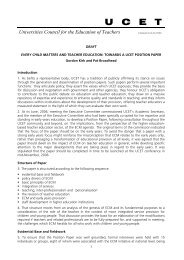Introduction 'Does my VDU affect my health?' - PGCE
Introduction 'Does my VDU affect my health?' - PGCE
Introduction 'Does my VDU affect my health?' - PGCE
You also want an ePaper? Increase the reach of your titles
YUMPU automatically turns print PDFs into web optimized ePapers that Google loves.
Working with<br />
Health and Safety Executive<br />
<strong>VDU</strong>s<br />
This is a web-friendly version of leaflet INDG36(rev3), revised 12/06<br />
<strong>Introduction</strong><br />
This leaflet is a guide for people who work with visual display units (<strong>VDU</strong>s), and their<br />
employers. It:<br />
answers questions that are most often asked about <strong>VDU</strong>s and <strong>health</strong> (see page );<br />
gives a summary of the law on <strong>VDU</strong> work (the Health and Safety (Display Screen<br />
Equipment) Regulations 992), and outlines what employers and employees should do to<br />
comply (see page 4);<br />
suggests some simple adjustments that users can make to workstations and screens to make<br />
them more comfortable and easy to use (see page 5); and<br />
explains how employers and users can get further advice (see page 7).<br />
What’s the difference between a <strong>VDU</strong>, a VDT, a monitor and display<br />
screen equipment (DSE)<br />
There isn’t one. All these terms mean the same thing - a display screen, usually forming<br />
part of a computer and showing text, numbers or graphics.<br />
This booklet gives advice on <strong>health</strong> and safety in working with such screens. It covers<br />
both conventional (cathode ray tube, TV-style) screens and the newer flat-panel<br />
displays such as those used in portable computers.<br />
The advice in this booklet applies to the whole workstation, job and work<br />
environment, as well as to the <strong>VDU</strong>, keyboard and other equipment.<br />
‘Does <strong>my</strong> <strong>VDU</strong> <strong>affect</strong> <strong>my</strong> <strong>health</strong>’<br />
Answers to some common questions from <strong>VDU</strong> users<br />
Am I at risk<br />
<strong>VDU</strong>s have been blamed - often wrongly - for a wide range of <strong>health</strong> problems. In fact, only<br />
a small proportion of <strong>VDU</strong> users actually suffer ill <strong>health</strong> as a result of their work. Where<br />
problems do occur, they are generally caused by the way in which <strong>VDU</strong>s are being used,
ather than the <strong>VDU</strong>s themselves. So problems can be avoided by good workplace and job<br />
design, and by the way you use your <strong>VDU</strong> and workstation.<br />
Are aches and pains caused by using a <strong>VDU</strong> What about ‘RSI’<br />
Some users may get aches and pains in their hands, wrists, arms, neck, shoulders or back,<br />
especially after long periods of uninterrupted <strong>VDU</strong> work. ‘Repetitive strain injury’ (RSI) has<br />
become a popular term for these aches, pains and disorders, but can be misleading - it<br />
means different things to different people. A better medical
of 8 pages Health and Safety Executive<br />
name for this whole group of conditions is ‘upper limb disorders’. Usually these disorders do<br />
not last, but in a few cases they may become persistent or even disabling.<br />
How can I avoid these aches, pains and disorders<br />
Problems of this kind may have a physical cause, but may also be more likely if a <strong>VDU</strong><br />
user feels stressed by the work (see next question). If you get aches or pains you should<br />
alert your supervisor or line manager.<br />
Problems can often be avoided by good workplace design, so that you can work<br />
comfortably, and by good working practices (like taking frequent short breaks from the<br />
<strong>VDU</strong>). Prevention is easiest if action is taken early, before the problem has become serious.<br />
For more about how to avoid trouble, see ‘Making adjustments to suit your needs’ on page<br />
5.<br />
What can be done to reduce stress in <strong>my</strong> <strong>VDU</strong> work<br />
People who use a <strong>VDU</strong> sometimes complain of stress, but this usually arises from increased<br />
pace of work or pressure to meet deadlines, not the <strong>VDU</strong> itself. Some <strong>VDU</strong> workers find<br />
stress reduced because the <strong>VDU</strong> makes their job easier or more interesting, but for others<br />
stress becomes worse. This can happen when a system does not work well or when the user<br />
does not feel in control or competent to operate it.<br />
Employers can help overcome stress by providing the right training, and by designing<br />
systems and tasks to match the abilities of the people who work with them.<br />
Can work with <strong>VDU</strong>s <strong>affect</strong> eyesight<br />
Extensive research has found no evidence that <strong>VDU</strong>s can cause disease or permanent<br />
damage to eyes. But long spells of <strong>VDU</strong> work can lead to tired eyes and discomfort. Also,<br />
by giving your eyes more demanding tasks, it might make you aware of an eyesight<br />
problem you had not noticed before. You and your employer can help your eyes by<br />
ensuring your <strong>VDU</strong> is well positioned and properly adjusted, and that the workplace<br />
lighting is suitable. Ask for an eye test if you still think there is a problem.<br />
What about problems with <strong>my</strong> contact lenses or bifocals<br />
The heat generated by computers and other equipment can make the air seem drier,<br />
and some contact lens wearers find this uncomfortable. If you have this problem but<br />
don’t want to change to spectacles, you can try blinking more often or using tearsubstitute<br />
drops. Where the air is dry, employers can help by taking steps to increase the<br />
humidity.<br />
People with bifocal spectacles may find them less than ideal for <strong>VDU</strong> work. It is important<br />
to be able to see the screen easily without having to raise or lower your head. If you can’t<br />
work comfortably with bifocals, you may need a different type of spectacles. Consult your<br />
optician or doctor if in doubt.<br />
Can <strong>VDU</strong> work cause headaches<br />
Headaches may result from several things that occur with <strong>VDU</strong> work, such as:<br />
screen glare;<br />
poor image quality;<br />
a need for different spectacles;<br />
stress from the pace of work;<br />
anxiety about new technology;<br />
reading the screen for long periods without a break;
poor posture; or<br />
a combination of these.
Working with <strong>VDU</strong>s 2 of 8 pages Health and Safety Executive<br />
Many of these things can easily be put right once the cause of the problem has been<br />
found.<br />
How long should I work with a <strong>VDU</strong><br />
There is no legal limit, but you need to break up long spells of <strong>VDU</strong> work. How long you<br />
should work without a break depends on the type of work you are doing. See pages 4 and 6<br />
for further information.<br />
Do <strong>VDU</strong>s give out harmful radiation<br />
No. <strong>VDU</strong>s give out both visible light, which enables us to see the screen, and other forms of<br />
electromagnetic radiation which can be harmful above certain levels. However, the levels<br />
of radiation emitted from <strong>VDU</strong>s are well below the safe levels set out in international<br />
recommendations. So your employer doesn’t have to check radiation levels from your<br />
<strong>VDU</strong>, and you do not need any special devices such as spectacles, screens or aprons when<br />
using it.<br />
What should I do if I’m pregnant<br />
You don’t need to stop working with <strong>VDU</strong>s. Past concern, about reports of miscarriages and<br />
birth defects among some groups of <strong>VDU</strong> workers, has not been borne out by more recent<br />
research. Many scientific studies have now been carried out and, taken as a whole, these<br />
do not show any link between miscarriages or birth defects and working with <strong>VDU</strong>s.<br />
If you are anxious about your <strong>VDU</strong> or about work generally during pregnancy, you should<br />
talk to your doctor. Or you could talk to someone who is well informed about current<br />
scientific information and advice on <strong>VDU</strong>s.<br />
Can working with <strong>VDU</strong>s cause skin disorders<br />
This is rare. A few people have experienced irritation, rashes or other skin problems when<br />
working with a <strong>VDU</strong>. The exact cause is not known, but it seems possible that a combination<br />
of dry air, static electricity and individual susceptibility may be involved. If this is the case,<br />
increasing the humidity or allowing more fresh air into the room may help.<br />
Can <strong>VDU</strong>s trigger epileptic fits<br />
Most people with epilepsy are completely un<strong>affect</strong>ed by <strong>VDU</strong>s. A few who suffer from<br />
photo-sensitive epilepsy and are susceptible to flickering lights and striped patterns may<br />
be <strong>affect</strong>ed in some circumstances. But even they can often work successfully with <strong>VDU</strong>s<br />
without provoking an attack.<br />
I use a portable computer - are there any precautions I should take<br />
Laptops and other portables have to be compact and easy to carry. The resulting design<br />
features, like small keyboards, can make prolonged use uncomfortable, unless steps are<br />
taken to avoid problems, eg by using a docking station.<br />
It is best to avoid using a portable on its own if full-sized equipment is available. And like<br />
other <strong>VDU</strong> users, people who habitually use a portable should be trained how to minimise<br />
risks. This includes sitting comfortably, angling the screen so it can be seen clearly with<br />
minimal reflections, and taking frequent breaks if work is prolonged. Wherever possible,<br />
portables should be placed on a firm surface at the right height for keying.<br />
Is it true that using a mouse can cause problems<br />
Intensive use of a mouse, trackball, or similar pointing device may give rise to aches and<br />
pains in the fingers, hands, wrists, arms or shoulders. This can also happen with a keyboard,<br />
but mouse work concentrates activity on one hand and arm (and one or two fingers), and
this may make problems more likely. Risks can be reduced by adopting a good posture and<br />
technique - see pages 5 and 6.
Working with <strong>VDU</strong>s of 8 pages Health and Safety Executive<br />
Try to limit the time you spend using the mouse. Take frequent breaks - even short pauses<br />
to relax your arm can help, as can spells using the keyboard or doing non-computer work.<br />
Place the mouse close, so it can be used with a relaxed arm and straight wrist. It can help<br />
to support your arm, for example on the desk surface or arm of a chair. If you still find using<br />
the mouse awkward, you could try a different shaped or sized one, or another device such<br />
as a trackball.<br />
The Regulations and how they <strong>affect</strong> you<br />
The Health and Safety (Display Screen Equipment) Regulations 992 implement an EC<br />
Directive and came into effect from January 99 (some small changes were made in 2002).<br />
The Regulations require employers to minimise the risks in <strong>VDU</strong> work by ensuring that<br />
workplaces and jobs are well designed.<br />
Who is <strong>affect</strong>ed<br />
The Regulations apply where staff habitually use <strong>VDU</strong>s as a significant part of their normal<br />
work. Other people, who use <strong>VDU</strong>s only occasionally, are not covered by the requirements<br />
in the Regulations (apart from the workstation requirements). However, their employers still<br />
have general duties to protect them under other <strong>health</strong> and safety at work legislation.<br />
I am self-employed - am I covered<br />
The Regulations do not place any duties on the self-employed. However, parts of them<br />
apply if you habitually use a <strong>VDU</strong> for a significant part of your normal work and are using a<br />
client employer’s workstation. The client employer has to assess and reduce risks, ensure<br />
the workstation complies with the minimum requirements and provide information, as if<br />
you were an employee. But there is no requirement for employers to plan work breaks, or<br />
provide eye tests or training for the self-employed.<br />
I work at home - am I covered<br />
Yes, the Regulations apply if you are an employee working at home, and habitually using<br />
a <strong>VDU</strong> for a significant part of your normal work.<br />
What do employers have to do to comply<br />
The Regulations do not contain detailed technical specifications or lists of approved<br />
equipment. Instead, they set more general objectives.<br />
Employers have to:<br />
Analyse workstations, and assess and reduce risks<br />
Employers need to look at:<br />
the whole workstation including equipment, furniture, and the work environment;<br />
the job being done; and<br />
any special needs of individual staff.<br />
Employees and safety representatives should be encouraged to take part in risk<br />
assessments, eg by reporting <strong>health</strong> problems. Where risks are identified, the employer<br />
must take steps to reduce them.
Working with <strong>VDU</strong>s 4 of 8 pages Health and Safety Executive<br />
Ensure workstations meet minimum requirements<br />
These requirements are good features that should normally be found in a workstation, such<br />
as adjustable chairs and suitable lighting. They are set out in a schedule to the<br />
Regulations, covering screens, keyboards, desks, chairs, the work environment and software.<br />
All workstations covered by the Regulations now have to comply, to the extent necessary for<br />
the <strong>health</strong> and safety of workers (a transitional period for modification of older workstations<br />
expired at the end of 996).<br />
Plan work so there are breaks or changes of activity<br />
As the need for breaks depends on the nature and intensity of the work, the Regulations<br />
require breaks or changes of activity but do not specify their timing or length. However the<br />
guidance on the Regulations explains general principles, for example short, frequent<br />
breaks are better than longer, less frequent ones. Ideally the individual should have some<br />
discretion over when to take breaks.<br />
On request arrange eye tests, and provide spectacles if special ones are needed<br />
Employees covered by the Regulations can ask their employer to provide and pay for an<br />
eye and eyesight test. This is a test by an optometrist or doctor. There is also an<br />
entitlement to further tests at regular intervals; the optometrist doing the first test can<br />
recommend when the next should be. Employers only have to pay for spectacles if special<br />
ones (for example, prescribed for the distance at which the screen is viewed) are needed<br />
and normal ones cannot be used.<br />
Provide <strong>health</strong> and safety training and information<br />
Employers have to provide training, to make sure employees can use their <strong>VDU</strong> and<br />
workstation safely, and know how to make best use of it to avoid <strong>health</strong> problems, for<br />
example by adjusting the chair.<br />
Information should also be provided about <strong>VDU</strong> <strong>health</strong> and safety. This should include<br />
general background information - this could be done by giving out copies of this booklet.<br />
It should also cover more specific details of the steps taken by the employer to comply<br />
with the Regulations, such as the action taken to reduce risks and the arrangements for<br />
breaks.<br />
Details of more comprehensive HSE guidance publications on the Regulations are given on<br />
page 7.<br />
Making adjustments to suit your needs<br />
What can I do to help <strong>my</strong>self<br />
Make full use of the equipment provided, and adjust it to get the best from it and to avoid<br />
potential <strong>health</strong> problems. If the Regulations apply to you, your employer should cover<br />
these things in training. If the Regulations don’t apply, it is still worth setting up your<br />
workstation properly, to be as comfortable as possible.<br />
Here are some practical tips:<br />
Getting comfortable
Adjust your chair and <strong>VDU</strong> to find the most comfortable position for your work. As a broad<br />
guide, your forearms should be approximately horizontal and your eyes the same height as<br />
the top of the <strong>VDU</strong>.<br />
Make sure you have enough work space to take whatever documents or other equipment<br />
you need.<br />
■ Try different arrangements of keyboard, screen, mouse and documents to find the<br />
best arrangement for you. A document holder may help you avoid awkward
Working with <strong>VDU</strong>s 5 of 8 pages Health and Safety Executive<br />
neck and eye movements.<br />
Arrange your desk and <strong>VDU</strong> to avoid glare, or bright reflections on the screen. This will be<br />
easiest if neither you nor the screen is directly facing windows or bright lights. Adjust<br />
curtains or blinds to prevent unwanted light.<br />
Make sure there is space under your desk to move your legs freely. Move any obstacles such<br />
as boxes or equipment.<br />
Avoid excess pressure from the edge of your seat on the backs of your legs and knees. A<br />
footrest may be helpful, particularly for smaller users.<br />
Keying in<br />
Adjust your keyboard to get a good keying position. A space in front of the keyboard is<br />
sometimes helpful for resting the hands and wrists when not keying.<br />
Try to keep your wrists straight when keying. Keep a soft touch on the keys and don’t<br />
overstretch your fingers. Good keyboard technique is important.<br />
Reading the screen<br />
Using a mouse<br />
Position the mouse within easy reach, so it can be used with the wrist straight. Sit upright<br />
and close to the desk, so you don’t have to work with your mouse arm stretched. Move the<br />
keyboard out of the way if it is not being used.<br />
Support your forearm on the desk, and don’t grip the mouse too tightly.<br />
Rest your fingers lightly on the buttons and do not press them hard.<br />
Reading the screen<br />
Adjust the brightness and contrast controls on the screen to suit lighting conditions in the<br />
room.<br />
Make sure the screen surface is clean.<br />
In setting up software, choose options giving text that is large enough to read easily on your<br />
screen, when you are sitting in a normal, comfortable working position. Select colours that<br />
are easy on the eye (avoid red text on a blue background, or vice-versa).<br />
Individual characters on the screen should be sharply focused and should not flicker or<br />
move. If they do, the <strong>VDU</strong> may need servicing or adjustment.
Working with <strong>VDU</strong>s 6 of 8 pages Health and Safety Executive<br />
Posture and breaks<br />
Don’t sit in the same position for long periods. Make sure you change your posture as often<br />
as practicable. Some movement is desirable, but avoid repeated stretching to reach things<br />
you need (if this happens a lot, rearrange your workstation)<br />
Most jobs provide opportunities to take a break from the screen, eg to do filing or<br />
photocopying. Make use of them. If there are no such natural breaks in your job, your<br />
employer should plan for you to have rest breaks. Frequent short breaks are better than fewer<br />
long ones.<br />
More information and advice<br />
The Health and Safety Executive (HSE) has published two other guidance booklets giving<br />
detailed information on the Display Screen Equipment Regulations. Employers in particular<br />
may wish to consult one of them. The two booklets are:<br />
■ The law on <strong>VDU</strong>s: An easy guide: Making sure your office complies with the Health and<br />
Safety (Display Screen Equipment) Regulations 1992 (as amended in 2002) HSG90<br />
HSE Books 200 ISBN 0 7 76 2602 4<br />
This is the booklet HSE recommends for most employers who have staff using<br />
standard <strong>VDU</strong>s in offices. It gives practical guidance, in plain language, on how<br />
to comply with the Regulations with a minimum of effort and expense. It is<br />
illustrated in colour and includes a checklist for workstation assessment.<br />
Note: additional copies of the <strong>VDU</strong> workstation checklist are available in priced<br />
packs of 5, ISBN 0 7 76 26 7 2.<br />
■ Work with display screen equipment. Health and Safety (Display Screen Equipment)<br />
Regulations 1992 as amended by the Health and Safety (Miscellaneous Amendments)<br />
Regulations 2002. Guidance on regulations<br />
L26 (Second edition) HSE Books 200 ISBN 0 7 76 2582 6<br />
This booklet in HSE’s Legal series gives comprehensive guidance on interpretation of<br />
each part of the Regulations. It includes the text of the Regulations themselves,<br />
including the 2002 amendments. It will be of most interest to employers who need to<br />
check the detail of particular requirements, or anyone who wants advice on application<br />
of the Regulations to display screen equipment other than ordinary <strong>VDU</strong>s in offices.<br />
All these publications are available from HSE Books (see back cover) or booksellers.<br />
What should I do if I have any problems<br />
If you are a <strong>VDU</strong> user and think you have <strong>health</strong> problems connected with your work, it’s<br />
best to talk to your supervisor, manager or safety representative first. Employers have a<br />
duty to consult their employees or employee representatives on <strong>health</strong> and safety issues.<br />
It is good practice for employers to encourage early reporting of <strong>health</strong> problems, help<br />
sufferers obtain treatment they need, and help them return to work.<br />
If this doesn’t help, <strong>VDU</strong> users and employers can get advice from the relevant<br />
authority:<br />
For <strong>VDU</strong> work in an office, shop or hotel: contact the Environmental Health Department at<br />
your local council.
For other premises (and government offices): contact your nearest local office of the Health<br />
and Safety Executive, as listed in the telephone directory.
Working with <strong>VDU</strong>s 7 of 8 pages Health and Safety Executive<br />
HSE priced and free publications are available by mail order from HSE Books, PO Box 999,<br />
Sudbury, Suffolk CO 0 2WA Tel: 0 787 88 65 Fax: 0 787 995 Website: www.hsebooks.co.uk<br />
(HSE priced publications are also available from bookshops and free leaflets can be<br />
downloaded from HSE’s website: www.hse.gov.uk.)<br />
For information about <strong>health</strong> and safety ring HSE’s Infoline Tel: 0845 45 0055 Fax: 0845<br />
408 9566 Textphone: 0845 408 9577 e-mail: hse.infoline@natbrit.com or write to HSE<br />
Information Services, Caerphilly Business Park, Caerphilly CF8 GG.<br />
This leaflet contains notes on good practice which are not compulsory but which you<br />
may find helpful in considering what you need to do.<br />
This leaflet is available in priced packs of 0 from HSE Books, ISBN 0 7 76 6222 5. Single<br />
copies are free and a web version can be found at www.hse.gov.uk/pubns/ indg 6.pdf.<br />
© Crown copyright This publication may be freely reproduced, except for<br />
advertising, endorsement or commercial purposes. First published 2/06. Please<br />
acknowledge the source as HSE.
Published by the Health and Safety Executive INDG 6(rev ) 8 of 8 pages



